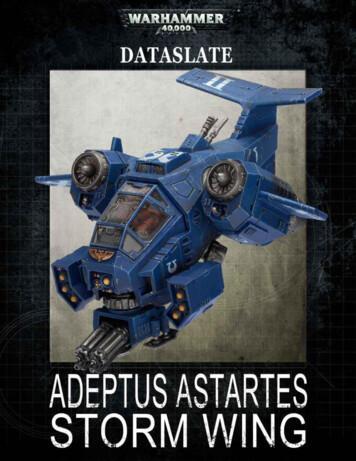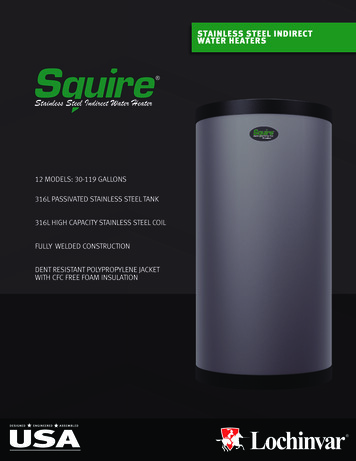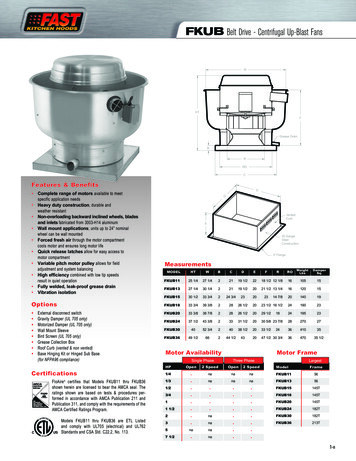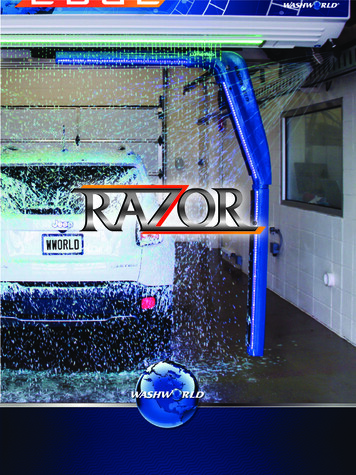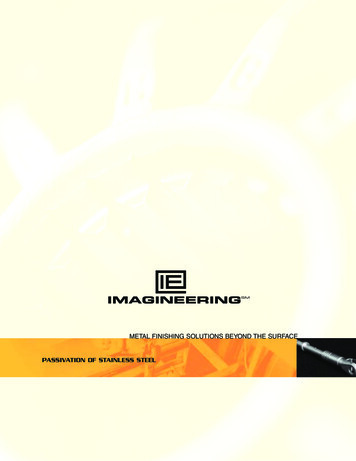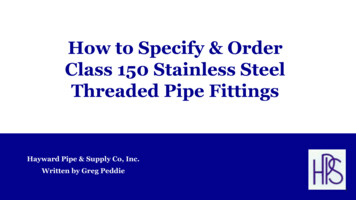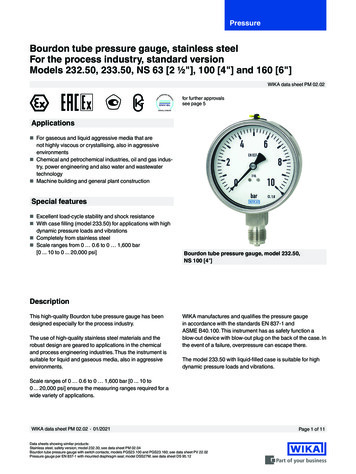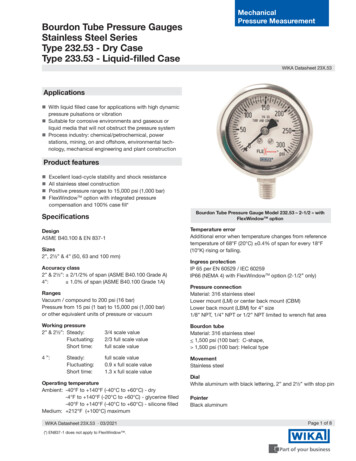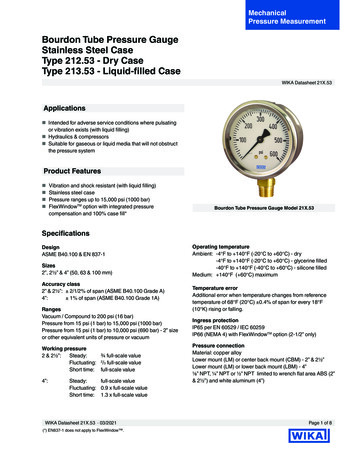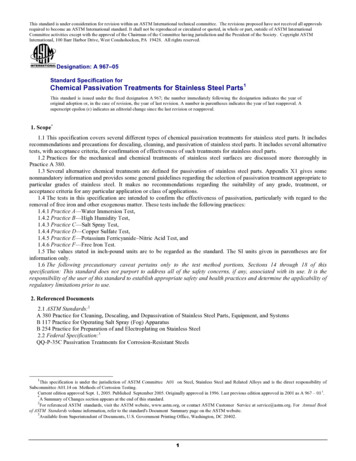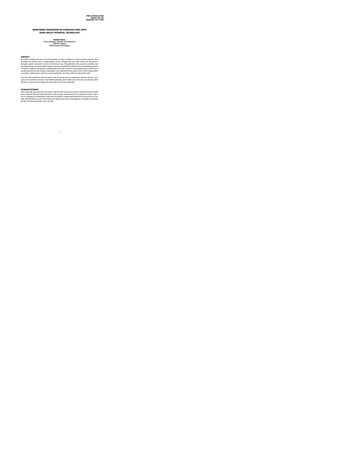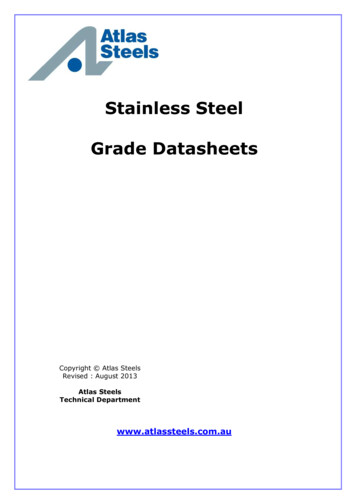
Transcription
Stainless SteelGrade DatasheetsCopyright Atlas SteelsRevised : August 2013Atlas SteelsTechnical Departmentwww.atlassteels.com.au
ATLAS STEELS Stainless Steels Grade DatasheetsFOREWORDThis compilation of stainless steel Grade Datasheets has been produced by Atlas Steels Technical Department asa companion to the Atlas Technical Handbook of Stainless Steels. Any suggestions for improvements, additionsor corrections would be very welcome; these should be directed to:Technical Manager, Atlas SteelsTelephone 61 3 8383 9863, email peter.moore@atlassteels.com.auIndividual grade datasheets are available from the Atlas Steels website. Information from any Atlaspublication can be freely copied, but it is requested that the source be acknowledged.Limitation of LiabilityThe information contained in these datasheets is not an exhaustive statement of all relevant information. It is ageneral guide for customers to the products and services available from Atlas Steels and no representation ismade or warranty given in relation to this information or the products or processes it describes.Published by Atlas Steels Technical DepartmentCopyright Atlas Steelswww.atlassteels.com.au
Stainless Steel DatasheetsAustenitic Stainless Steels301, 301L, 301LN302HQ303, 303Se304, 304L, 304H310, 310S, 310H316, 316L, 316H321, 321H, 347253MA (S30815)904LHigh strength for roll formed structural componentsLow work hardening rate grade for cold heading fastenersFree-machining bar gradesStandard 18/8 gradesHigh temperature resistant gradesImproved resistance to pitting corrosion in chloride environmentsStabilised grades for heavy section welding and high temperature applicationsHigh temperature resistant gradeHigh resistance to general corrosion, pitting and stress corrosion crackingAtlasCR12AtlasCR12Ti409430, 430FF18S / 439F20SF18MS / 444Utility steel resistant to wet abrasion and mild corrosionUtility steel resistant to wet abrasion and mild corrosion – weld stabilisedAutomotive exhaust grade – weld stabilisedResistant to mildly corrosive environmentsResistant to mildly corrosive environments – weld stabilisedA ferritic alternative to grade 304 / 304L – weld stabilisedA ferritic alternative to grade 316 / 316L – weld stabilised21012304220525072507CuLean duplex – economical alternative to 304 and 316Duplex alternative to grade 316Standard duplex stainless steel - high resistance to pitting and stress corrosionSuper duplex with very high resistance to pitting and stress corrosionSuper duplex with very high resistance to pitting and stress corrosion410416420431440A, 440B, 440CStandard martensitic grade for low-duty hardened applicationsFree-machining bar gradeHigher hardness martensitic grade for cutlery, cutting tools and diesHigh hardness and toughness grade, primarily for shaftingVery high hardness grades used in cutting tools630(17-4PH) High strength shafting gradeFerritic Stainless SteelsDuplex Stainless SteelsMartensitic Stainless SteelsPrecipitation Hardening Stainless SteelNote that some of these stainless steel grades are commonly referred to by designations that are registeredtrademarks.Limitation of LiabilityThe information contained in this datasheet is not an exhaustive statement of all relevant information. It is a generalguide for customers to the products and services available from Atlas Steels and no representation is made or warrantygiven in relation to this document or the products or processes it describes.Revised November 2011www.atlassteels.com.auPage 1 of 1
Grade Data Sheet301 301L 301LNGrade 301 is a high work-hardening rateaustenitic stainless steel. It can be suppliedwith a tensile strength of up to over 1300 MPain strip and wire forms, to produce tempers inthe range of 1/16 Hard to Full Hard. Thecontrolled analysis of Grade 301 enables it toretain sufficient ductility in conditions up to 1/2Hard conditions to be roll or brake formed intoaircraft, architectural and particularly rail carstructural components. However, 3/4 to FullHard tempers should be used whenever highwear resistance and spring features arerequired in components of simple form designs.required. The grades work harden at the veryhigh rate of approximately 14MPa/%Ra (14MPaincrease in tensile strength for each 1%reduction of area of cold work), resulting inhigh achievable strengths from cold rolling andfromrollforming.Thestrain-hardenedaustenite is at least partially transformed tomartensite by this work. Despite the highstrengths achieved there is still enoughresidual ductility to enable significant colddeformation. Although non-magnetic in theannealed condition, when cold worked thegrades become strongly attracted to a magnet.Grade 301L with low carbon is preferred forimproved ductility or if heavy sections are to bewelded, and another variant 301LN has ahigher nitrogen content to compensate for thelower carbon.WeldingASTM A666 covers all three variants, and someare also included in Japanese specification JISG4305 and Euronorm EN 10088-2.Corrosion ResistanceCorrosion resistance is similar to that of 304.Good resistance in applications ns at ambient temperatures.Heat ResistanceGood oxidation resistance in intermittentservice to 840 C and in continuous service to900 C, although not usually chosen for thisenvironment. Exposure to temperatures aboveabout 400 C will result in progressive removalof work hardening effects; at approximately800 C the strength will be similar to anannealed 301. In creep applications a workhardened grade 301 can even reduce to lowerstrength than an annealed 301.Good characteristics suited to all standardmethods.Grade308Lfillerrodisrecommended. Welds in Grade 301 must beannealed for maximum corrosion resistance;this is not necessary in 301L or 301LN. Weldingand post weld annealing will both remove highstrength induced by prior cold rolling.Spot welding is commonly used to assemblecold rolled 301 components. The very smallheat affected zone associated with this rapidwelding technique results in little reduction ofoverall component strength.Typical ApplicationsRail car structural components - often rollformed, brake pressed or stretch formed toprofiles but also used flat. Airframe sections.Highway trailer components. Automotive wheelcovers, wiper blade holders and clips. Toastersprings, stove element clips. Screen frames,curtain walls.Heat TreatmentSolution Treatment (Annealing)Heat to 1010-1120 C and cool rapidly. Use lowside of range for intermediate annealing. Thisgrade cannot be hardened by thermaltreatment.Cold WorkingGrade 301 and its low carbon variants are usedwhere a high strength stainless steel isRevised May 2008www.atlassteels.com.auPage 1 of 2
Grade Data Sheet301 301L 301LNSpecified PropertiesThe properties for Grade 301 are specified for flat rolled product (plate, sheet and coil) in ASTMA666. Similar but not identical mechanical properties are specified in EN 10088.2 and JIS G4305and in proprietary specifications.Composition Specification 08.06.08.0-N0.100.200.070.20Mechanical Property Specification (Grade 301 – other values for 301L and 301LN)Grade 301TemperASTM A666Bend Test(1.27 - 4.76mm thick)Bend AngleFactor( )(Note 1)Annealed5152054018011/16 Hard6203104018011/8 Hard6903804018011/4 Hard860515259021/2 Hard1035760189023/4 Hard120593012903Full Hard12759659905Notes 1. Bend test is around a diameter of the Bend Factor multiplied by the steel thickness.2. Hardness values are typical industry standard – there are no specified limits.TensileStrength(MPa)min.Yield Strength0.2% Proof(MPa)min.Elongation(% in 50mm)(thick. 0.76mm)min.HardnessRockwellC(Note 2)25 – 3232 – 3737 – 4141 Physical Properties (Grades 301, 301L and 301LN - typical values in the annealed condition)GradeDensity3(kg/m )All7900ElasticModulus(GPa)193Mean Coefficient of ThermalExpansionThermalConductivity0-100 C0-315 C0-538 Cat 100 C at 500 C( m/m/ C) ( m/m/ C) ( m/m/ C) (W/m.K) esistivity0-100 C( J/kg.K)(n .m)500720Grade Specification eJIS301S301001.4319X5CrNi17-7SUS ese comparisons are approximate only. The list is intended as a comparison of functionallysimilar materials not as a schedule of contractual equivalents. If exact equivalents are neededoriginal specifications must be consulted. Different comparisons apply to grades 301L and 301LN.Possible Alternative GradesGrade304316Why it might be chosen instead of 301 / 301L / 301LNBetter availability, lower cost; the lower work hardening rate of 304 is acceptable.Higher corrosion resistance needed; the lower work hardening rate of 316 is acceptableLimitation of LiabilityThe information contained in this datasheet is not an exhaustive statement of all relevant information. It is a generalguide for customers to the products and services available from Atlas Steels and no representation is made or warrantygiven in relation to this document or the products or processes it describes.Revised May 2008www.atlassteels.com.auPage 2 of 2
Grade Data Sheet302HQGrade 302HQ is a specialised wire grade withvery wide usage for manufacture of stainlesssteel fasteners. The inclusion of 3% copper inthe composition reduces the cold workhardening rate substantially compared toGrade 304. 302HQ is standard for manufactureof self-tapping screws and light machinescrews; it is also used for some bolts, setscrews, rivets and specialised fasteners. It hasnow totally replaced Grades 384 and 305 forcold heading applications, copper being a lowercost alternative to their high nickel contents.The designation 302HQ is not standardised –ASTM specifications list the grade as UNSS30430, and alternative designations for thesame grade include "XM-7", "304Cu" and"304HQ". The standard specification forstainless steel fasteners, ISO 3506, includes302HQ as an acceptable composition forfastener grade “A2”; it is commonly producedin strength grades A2-70 and A2-80.The stable austenitic structure makes 302HQnon-magnetic, even after substantial coldwork, and also results in excellent toughness,even down to cryogenic temperatures.Corrosion ResistanceEqual to or exceeding that of Grade 304.Subject to pitting and crevice corrosion inwarm chloride environments, and to stresscorrosion cracking above about 50 C. 302HQ isconsidered resistant to potable water with upto about 200mg/L chlorides at ambienttemperatures, reducing to about 150mg/L at60 C. Consult Atlas Technical Assistance forspecific environmental recommendations.Heat ResistanceWeldingUse Grade 308L rods or electrodes. Excellentweldability by all standard fusion methods,both with and without filler metals. Because ofits applications this grade is not often welded.Exceptions are resistance butt welding to joinwires together during wire manufacture, andwhen the grade is used to make stud weldingfasteners. 302HQ is not specifically listed in AS1554.6.Machining302HQ is rarely machined, because of its formand likely products. The grade always has verylow sulphur content as this aids formability, butunfortunately this also reduces machinability.Machining is certainly possible.An Improved Machinability version of Grade302HQ is produced, having a very highmachinability. This version has a slightly highersulphur content and is also calcium treated.This Improved Machinability grade (referred toas Ugima 4567) is available only to specialorder, but should be considered as an optionwhere an “18/8” type grade needs to be bothheavily cold formed and extensively machined.Cold Work Hardening302HQ has the lowest work hardening rate ofany of the common austenitic stainless steels.This results in a tensile strength increase ofapproximately 8MPa/%Ra (8MPa increase intensile strength for each 1% reduction of areaof cold work - this data from wire drawing).Even after substantial cold work this graderemains essentially non-responsive to amagnet.Good oxidation resistance in intermittentservice to 870 C and in continuous service to925 C. Continuous use of Grade 302HQ in 425860 C range is usually safe (free of carbideprecipitation) as the grade has a very lowcarbon content.For some high strength cold headed fasteners aslightly higher work hardening rate will beneeded, so grade 304 or 304L (or the specialistgrade 304M) will need to be used instead of302HQ; these have work hardening ratesvarying between about 10 and 12.5MPa/%RA.Heat TreatmentSolution Treatment (Annealing)Typical ApplicationsHeat to 1010-1120 C and cool rapidly. Thisgrade cannot be hardened by thermaltreatment.Revised May 2008All severe cold heading applications, includingself-tapping screws, roofing bolts, machinescrews, bolts, set screws, blind rivets.www.atlassteels.com.auPage 1 of 2
Grade Data Sheet302HQSpecified PropertiesThese properties are specified for grade S30430 wire in ASTM A493; wire is the only commonlyavailable form for this grade. Properties of finished fasteners are covered by other specifications,such as ISO 3506-1 and 3506-3.Composition Specification ical Property radeTensileYield StrengthElongationHardnessStrength0.2% Proof(% inBrinellRockwell B(MPa)(MPa)50mm)(HRB)(HB)max.302HQ annealed605302HQ lightly drawn660Above values from ASTM A493 for diameters 2.5mm and above. Higher strengths can be produced byheavy cold work - this may be required for certain applications, which should be discussed with AtlasTechnical Department.Physical us(GPa)193(typical values in the annealed condition)Mean Coefficient of ThermalExpansionThermalConductivity0-100 C0-315 C0-538 Cat 100 C at 500 C( m/m/ C) ( m/m/ C) ( m/m/ C) (W/m.K) (W/m.K)17.217.818.816.321.5Spec
ASTM A666 Tensile Strength (MPa) min. Yield Strength 0.2% Proof (MPa) min. Elongation (% in 50mm) (thick. 0.76mm) min. Bend Angle ( ) Factor (Note 1) Hardness Rockwell C (Note 2) Annealed 515 205 40 180 1 1/16 Hard 620 310 40 180 1 1/8 Hard 690 380 40 180 1 1/4 Hard 860 515 25 90 2 25 – 32 1/2 Hard 1035 760 18 90 2 32 – 37 3/4 Hard 1205 930 12 90 3 37 – 41 Full Hard 1275 965 9 90 5 41 .
